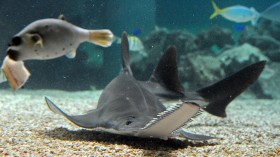Our own Milky Way galaxy harbors thousands of potentially habitable planets, telling scientists that in the search for life not on Earth, they should be looking a little closer to home.
That's at least according to a new study published in the journal Monthly Notices of the Royal Astronomical Society, which describes how scientists used data from NASA's Kepler satellite to work out that billions of stars in the Milky Way could have one to three planets in the "habitable zone" suitable for liquid water - and possibly life.
At least, that's just a theory. Those calculations are actually based on an updated version of the 250-year-old Titius-Bode law, which states that there is a certain ratio between the orbital periods of planets in a solar system. Using this, astronomers looked to find out how many stars could have planets in the habitable zones.
So far, Kepler has discovered about 1,000 planets around the stars in the Milky Way, as well as about 3,000 potential planets. Many stars have systems with two to six planets, but there could very well be more that are simply unobservable with Kepler.
"We decided to use this method to calculate the potential planetary positions in 151 planetary systems, where the Kepler satellite had found between 3 and 6 planets. In 124 of the planetary systems, the Titius-Bode law fit with the position of the planets," researcher Steffen Kjær Jacobsen said in a statement.
"Using T-B's law we tried to predict where there could be more planets further out in the planetary systems. But we only made calculations for planets where there is a good chance that you can see them with the Kepler satellite," he added.
They predicted a total of 228 planets in the 151 planetary systems by inserting the probable location of planets into the pattern among those whose sequence can already be observed. They also added an extra planet beyond the outermost known planet in the sequence. (Scroll to read on...)
The habitable zone, it should be noted, is not a fixed distance. It varies from star to star. The size and brightness of the star will determine the "just right" Goldilocks distance from the planet where there could be liquid water - too close and conditions are too hot, whereas too far means the planet will be a frozen, inhospitable world.
According to these most recent calculations, there were one to three planets in the habitable zone of each planetary system that was studied. However, there is the possibility that in the Milky Way alone, there are billions of stars with planets in the habitable zone.
Now that researchers have pointed out potential candidates for where life could exist, they hope that follow-up studies on these planetary systems will confirm their predictions.
"We have encouraged other researchers to look for these. If they are found, it is an indication that the theory stands up," Jacobsen concluded.
This isn't the first time astronomers have gotten their hopes up about life outside of Earth. Thanks to planet-hunting Kepler and other telescopes, we know now of 1,000 worlds that could support life. And this doesn't just include the Milky Way, but even our own solar system. Astronomers are buzzing about Saturn's moons Titan and Enceladus, and Jupiter's icy satellite Europa and most recently its neighbor Ganymede, which could be hiding a secret ocean 10 times deeper than Earth's.
NASA scientists are convinced that we are not alone in the Universe, and it seems that we are closer now more than ever in finding life beyond Earth.
For more great nature science stories and general news, please visit our sister site, Headlines and Global News (HNGN).
© 2024 NatureWorldNews.com All rights reserved. Do not reproduce without permission.
![Severe Thunderstorm Alert: Tornadoes, Damaging Winds and Hail Possible from Upper Ohio Valley to Northeast US [NWS]](https://1471793142.rsc.cdn77.org/data/thumbs/full/70161/280/157/50/40/severe-thunderstorm-alert-tornadoes-damaging-winds-and-hail-possible-from-upper-ohio-valley-to-northeast-us-nws.jpg)




